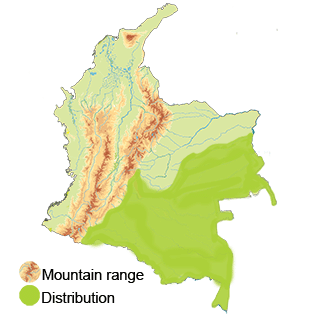Great-billed Hermit
The Great-billed Hermit (Phaethornis malaris)
Appearance: The Great-billed Hermit is a large hummingbird with a distinctive appearance. It has a long, slightly decurved bill, which is one of its defining features. The upperparts are generally dull green, the underparts buffy or cinnamon-colored, and it has a conspicuous white postocular stripe behind the eye. This species also exhibits white tips on the outer tail feathers.
Habitat: In Colombia, the Great-billed Hermit is found in humid forests, including lowland and foothill forests, as well as second-growth habitats. These hummingbirds prefer dense vegetation in areas with thick undergrowth and tall trees where they can forage for nectar and insects.
Behavior: The Great-billed Hermit is known for its solitary and territorial behavior. They are often seen perched motionless for extended periods, waiting to ambush flying insects or visiting flowers for nectar. These hummingbirds are less active and more inconspicuous compared to some other hummingbird species.
Breeding: The breeding biology of the Great-billed Hermit involves courtship displays, nest-building, and parental care. They construct small cup-shaped nests made of plant fibers, cobwebs, and other materials placed on a horizontal branch. The female lays two white eggs, and both parents participate in incubation and feeding the young.
Conservation Status: The Great-billed Hermit is considered a species of Least Concern in Colombia.
Distribution
The Great-billed Hermit ( Phaethornis malaris) East and South Colombia and the Amazon region
Taxonomy
The Great-billed Hermit ( Phaethornis malaris)
- Kingdom: Animalia
- Phylum: Chordata
- Class: Aves (Birds)
- Order: Caprimulgiformes
- Family: Trochilidae
- Genus: Phaethornis
- Species: Phaethornis malaris
Vocalization
Vocal communication plays a crucial role in the behavior of Great-billed Hermits within their habitats.
- Territorial Defense: Great-billed Hermits use vocalizations to define and defend their territories. Their calls can serve as warning signals to other individuals of the same species to stay away from their established feeding and breeding areas.
- Mate Attraction: Males often use their distinctive vocalizations to attract females during the breeding season. The rhythmic and repeated nature of their calls can be a way for males to advertise their presence and breeding readiness to potential mates.
- Social Interactions: Vocalizations can also be used in social interactions between individuals of the same species. Different types of calls may convey information about the bird's status, intentions, or emotions, helping to maintain social cohesion within the population.
- Navigational Aid: In dense forest habitats, where visual cues may be limited, vocalizations can help individuals locate and communicate with each other. This is especially important for maintaining contact between mates or during group foraging activities.
- Alarm Calls: Great-billed Hermits may have specific vocalizations that serve as alarm calls, alerting nearby individuals to the presence of predators or other potential threats. This helps to coordinate group responses and increase overall safety within the population.





